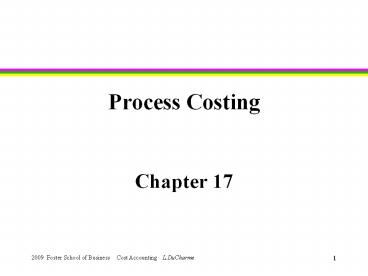Process Costing - PowerPoint PPT Presentation
Title:
Process Costing
Description:
Process Costing Chapter 17 Overview Process Costing When to use Accounting issue Equivalent Units (EUs) Mechanics of process costing w/o TI costs with TI costs ... – PowerPoint PPT presentation
Number of Views:1886
Avg rating:3.0/5.0
Title: Process Costing
1
Process Costing
- Chapter 17
2
OverviewProcess Costing
- When to use
- Accounting issue
- Equivalent Units (EUs)
- Mechanics of process costing
- w/o TI costs
- with TI costs
- Accounting for Spoilage (chapter 18)
3
When is it appropriate to useprocess costing?
- Or what companies use process costing?
- Which companies would not use process costing?
4
Illustrating Process Costing
Direct Materials, Direct Labor Indirect
Manufacturing Costs
Department A
Department B
Finished Goods
Cost of Goods Sold
5
What is the BIG accounting issue?
- The task is to divide the total costs in WIP
between ending WIP and inventory completed and
transferred out (CTO). - This is no big deal until you consider that E.WIP
is partially completed and CTO by definition is
100 complete (for each step of production)!
What do we do?
6
Equivalent Units
- 15 half-time (50) professors is equivalent to
7.5 full-time professors. Often for people we
refer to FTEs. - 100 teddy bears that are (on average) 45
complete are equivalent to 45 completed bears
45 equivalent units.
7
EUwhen to use
- Not all organizations that use process costing
have to calculate EUs! - You only have to calculate/use EUs when ending
WIP inventories are material. - No (or little) ending WIPwhat companies?
- Material ending WIPwhat companies?
8
Assumed flow of costs
- Process costing is combined with the assumed flow
of costs - Standard cost
- Weighted average (we will focus on this)
- FIFO (least used)
9
Three Equations/steps
- At the core of calculations are 3 equations
- Physical unit calculations (in units)
- B.WIP units started this period CTO E.WIP
- EU calculations (in EU)
- B.WIP work done this period CTO E.WIP
- Costs (in )
- B.WIP periods costs CTO E.WIP
10
Timing of added costs
- Whenever a factor of production is added at a
different time (beginning, middle, end, etc.) in
production, a separate EU computation is required
(for that factor)! - For example if DM is added at a different time
than CC, each has to have a separate EU
calculation (see example in class)
11
Transferred In Costs
- CTO from one department is TI to the next
department. - TI does not equal direct materials.
12
The BIG Picture
- The goal is to assign costs to CTO units. In
order to do this you need costs per unit. - When costs change from period to period, you have
to make a cost-flow assumption. - When incomplete units are present in E.WIP, you
have to adjust via EU calculations.
13
Process Costing Examples
- (1) Without TI costs
- (2) With TI costs
- My format
14
Process Costing--WA method
P.U. DM CC
WIP, Apr.1 300 7,500 2,125
Started in Apr. (or work done) 2,200
CTO Apr.
WIP, Apr.30 500
Cost added in Apr. 70,000 42,500
Apr. 1, complete 100 40
Apr. 30, complete 100 25
15
WA-- solution
P.U. DM EU-DM CC EU-cc
WIP, Apr.1 300 7,500 300 2,125 120
Started in Apr. (or work done) 2,200
CTO Apr. 2,000 2,000 2,000
WIP, Apr.30 500 500 125
Cost added in Apr. 70,000 42,500
Total Cost 77,500 44,625
WA /EU 31 / EU 21 /EU
16
WA--solution
DM CC Total
CTO (2,000 EU) 2,000 eu 31/eu 62,000 2,000 eu 21/eu 42,000 104,000
E.WIP (500 125 EU) 500 eu 31/eu 15,500 125 eu 21/eu 2,625 18,125
Total 77,500 44,625 122,125
17
WA with TI costs--example
- Finishing department (assume that)
- TI costs are added at the beginning
- DM are added at the end
- CC are added evenly throughout
18
Data for problem
P.U. TI TI-eu DM DM-eu CC CC-eu
B.WIP 500 17,750 100 0 0 7,250 60
Started (or work done) 2,000
CTO 2,100
E.WIP 400 100 0 30
Costs Added 104,000 23,100 38,400
Total 121,750 23,100 45,650
19
WA with TI costs--solution
P.U. TI DM CC
B.WIP 500 17,750 0 7,250
Started (or work done) 2,000
CTO 2,100
E.WIP 400
Total 121,750 23,100 45,650
WA /EU
20
WA with TI costs--solution
TI DM CC Total
WA /EU 48.700 11.000 20.563
CTO 2,100 eu 102,270 23,100 43,182 168,552
E.WIP 400 0 120 19,480 0 2,468 21,948
Total 190,500
21
Chapter 18
- This chapter focuses on accounting for Spoilage
(flip side of product quality). - You are responsible for the first 3 pages of the
chapter and what is covered in class.
22
Terminology
- Spoilage
- Unacceptable product discarded or sold for
disposal value (e.g., Seconds). - Reworked units
- Unacceptable product that is reworked and sold as
good product. - Scrapmaterial left over with min. or zero sales
value. - Wastecan be toxic and very costly to dispose of.
23
Goal of most operations
- Reduction of S/R/S/W
- Consistent with increased quality
- RD and design play key roles in reducing S/R/S/W.
24
Types of spoilage
- Normal spoilage
- Expected spoilage with efficient operations.
- Abnormal spoilage
- Unexpected (greater than expected) spoilage under
efficient operations. Considered avoidable
controllable. Some companies treat all spoilage
as abnormal!
25
Why do we care?
- Because we account for the two types
differently!! - Abnormal spoilage is expensed in the period it is
discovered. - Normal spoilage is added to job cost, or under
process costing added equally to all units
passing the inspection point.
26
Accounting for Spoilage
Job Costing Process Costing
Abnormal Spoilage Expense Expense
Normal Spoil. Due to this job Add to job cost N/A
Common to all Add to cost of all via MOH Add equally to all units passing inspection point
27
End of Chapter 17 18































